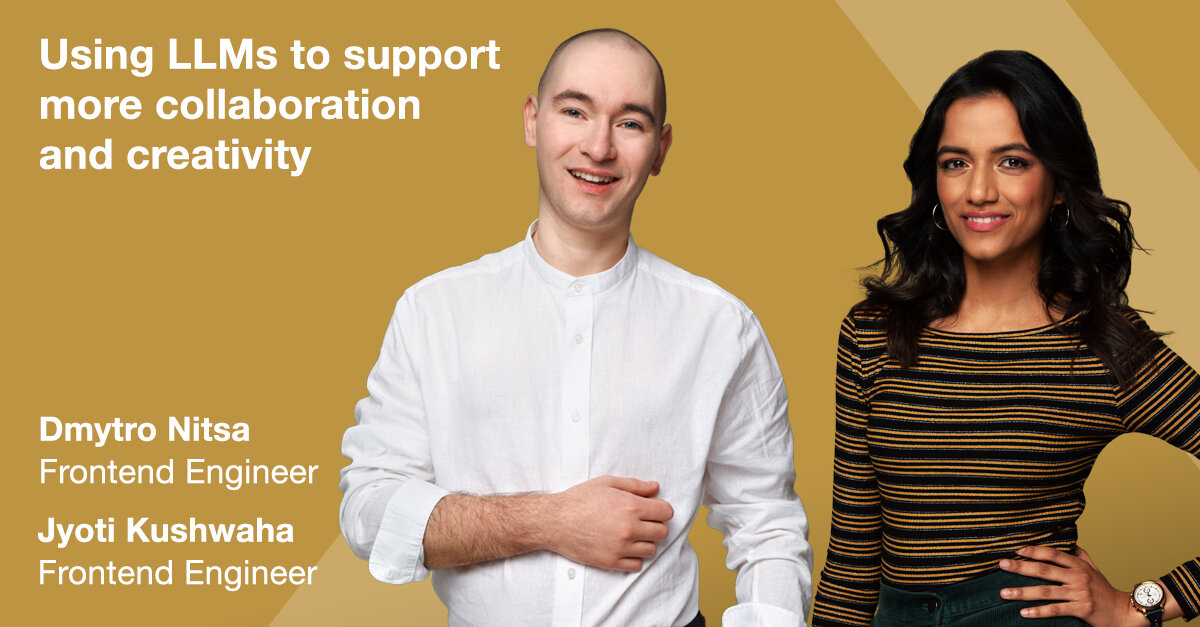
Search jobs
Help to shape the digital future of one of the world’s best-loved brands.
Miele X’s developers are using the latest tools to develop front-end systems that deliver a prestige, user-friendly experience to Miele’s customers around the world. We talked to Frontend Developers Dmytro Nitsa and Jyoti Kushwaha about how they’re using large language models (LLMs) to carry out more repetitive, mundane tasks and how this has given them more scope to think creatively and focus on delivering high-quality solutions.

Neither Dmytro nor Jyoti started their careers as frontend engineers, but both were attracted by the immediacy of working on frontend systems and seeing the results of their work straight away. And, as Dmytro points out, after working on QA, backend and full stack, he could see the reach of frontend development growing, particularly over the past few years. “It's such a wide topic nowadays. You can build anything with modern frameworks – both frontend and backend, with scalability. So, it's become a fascinating field.”
In particular, he says at Miele X, he can see the impact that quality frontend development has on Miele and its customers. “Nowadays, as well as visiting our physical stores, customers are browsing their phones, laptops, or iPads to purchase Miele products. So, the challenge we’ve set ourselves is replicating the premium experience that a customer receives in one of our physical stores in one of our digital ones. We need to create a brand identity that is striking and memorable and conveys Miele’s Immer Besser messaging in the frontend.”
As Jyoti points out, “We want to create a premium shopping experience that reflects the premium nature of our products. Rich, seamless, fast and enjoyable.”
Maintaining momentum
To deliver that premium experience, Dmytro says they’re using modern frameworks alongside older technology to improve accessibility, and adopting the GitHub Copilot LLM to speed up processes. “As frontend developers, our main role is connecting business requirements and logic with the technical world and creating a solution. But that can often involve mundane tasks, such as writing a simple function. That’s where LLMs come in.”
Jyoti adds that she finds LLMs useful for checking test data, which not only speeds up the process but also gives her more time to focus on the main part of her job. “Your brain doesn’t lose momentum because you’re still on the task, solving the problem. It just keeps you productive.”
“Of course, LLMs don't replace the human interaction of sitting down together and pair programming with someone else,” explains Dmytro. “But they do offer massive benefits of saving time and reducing repetitive tasks, when you prototype something or you want to build a feature.”
He gives an example of how the LLM has helped him to produce solutions quicker without a reduction in quality. “Using it gives you more time to collaborate with other engineers because you need less time to prototype a solution. Previously, it might have taken me a day to build something, and then I’d want another engineer to look at it. Right now, it'll take me two hours due to time savings on prototyping a code. I can do two or three iterations in a single week until we get to the point of ‘Immer Besser’ rather than spending several sprints trying to get it right. That's the value LLMs can add.”
Jyoti agrees, adding that she’s found LLMs can also be useful in helping her to look at things in a different way. “For example, yesterday, I was writing some test cases, and the Copilot tool generated a lot of scenarios for me. A couple of them were things I hadn't thought about initially. So, it helped by prompting me to think about it from another point of view.”
Supporting collaboration
However, Dmytro is quick to point out that LLMs can’t replicate the combined expertise of UX and UI designers, content managers, developers, and engineers. X-perts that come together to deliver a premium customer experience. “That all comes from the personal experiences of every person who builds it and adds to it. You can't put life experience into a machine – at least, not yet.”
But, he says, LLMs allow him to focus more on the quality of his work. “I definitely spend less time just typing down code and more time thinking if this is the right way to do it – is this the right solution? So, it’s given me more time actually to use my brain rather than my hands.”
And Jyoti adds that for her, it’s not just about having additional time to focus on the more interesting aspects of her role. She also feels she has extra scope to collaborate with colleagues and develop more rounded solutions. “When I was working on the new checkout journey, I used the LLM to generate things like dummy data. Which, in the past, I would have had to create myself. This then gave me more time to reach out to the UX team. Often, it depends on what you’re working on, but using an LLM can give you back the time you need to explore that creativity and connect with others.”
And she believes that having this additional time for collaboration means they can keep delivering the best solutions for Miele, “because everyone is aligned here – we want this for Miele, this is our vision, this is where we want to go.”